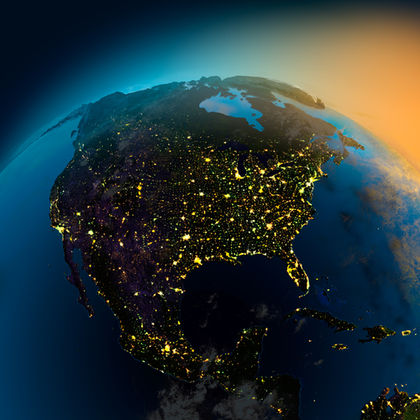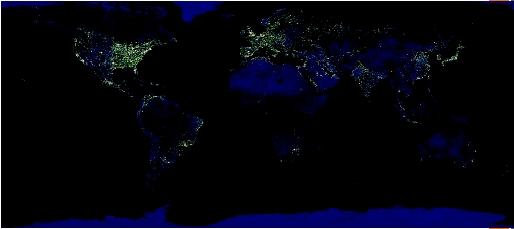Light Pollution

As humankind enters the twenty-first century, ours is the first generation where the majority of children cannot routinely see the night sky in all its splendor and glory. The problem is caused by light pollution, excess or misdirected artificial light that alters the natural night sky. In the night sky, light pollution causes an atmospheric phenomenon known as skyglow. You may have seen overhead clouds at night glowing with strange pink or orange colors; this is wasted light reflecting off the water particles that form clouds. Even without clouds, light shoots into the sky and reflects off of tiny airborne dust and moisture particles. The skyglow phenomenon directly affects the scientific research of amateur and professional astronomers. It also affects everyone else who simply enjoys a dark night sky abundant with stars overhead. Scientists say that nearly two-thirds of the U.S. population can no longer see the Milky Way.

On Hawaii's big island, Mauna Kea towers almost fourteen thousand feet above sea level and is home to the greatest collection of large telescopes on the earth. In several communities around the base of the mountain, the types of allowed nighttime lights have been restricted to keep the skies dark at the mountaintop—assuring that this site will remain one of the best in the world for astronomical research. This approach has also been successful in communities such as Tucson, Arizona, whose nearby Kitt Peak National Observatory has been in operation since the late 1960s.
On a somewhat smaller scale, in Springfield, Vermont, an annual telescope makers convention named Stellafane was threatened in the late 1990s by the lights of a nearby, newly constructed planned prison called Vermont Southern State Correctional Facility. Since 1920 as many as 3,000 telescope makers and stargazers from around the world have converged at this site to scan the dark New England skies with their homemade telescopes. When stargazing was threatened by the corrections facility's bright lights, telescope makers worked closely with prison officials to install appropriate lighting that maintained security, while minimizing its impact on the dark night sky.
Unfortunately, when the growth of lighting has gone unchecked, as in parts of California, instruments of great historical value, such as the two-hundred-inch Hale Telescope on Mount Palomar, have had their usefulness severely limited.
In an effort to assess the magnitude of the light pollution problem, a comprehensive World Atlas of Artificial Night Sky Brightness was produced in 2001 by researchers at the University of Padua, Italy, and the National Oceanic and Atmospheric Administration (NOAA). Thanks to work like this, light pollution is rapidly gaining recognition as a global economic issue. Although the problem is most pronounced among developed industrialized nations, it is also responsible for squandering the limited resources of poor and developing nations that can least afford the waste.
In 1988 a nonprofit educational research organization known as the International Dark Sky Association (IDA) was founded to increase awareness of and offer solutions to the problems associated with light pollution. The IDA currently has almost ten thousand members around the world, and has created the definitive collection of resources for the study of light pollution and its impact on the planet. Just a glance through the archives of the IDA reveals that light pollution has an impact on everything from humans to moths.
For example, in Florida, sea turtle hatchlings become disoriented by inland artificial lighting that confuses them during their first trip to the sea. It appears that artificial lights can distract the young turtles from needed optical clues (e.g., the sky reflecting off the ocean) which would normally lead them to the sea shortly after hatching. In some cases, nesting females also go astray for the same reason. This problem has prompted sixteen counties and forty municipalities in Florida to adopt coastal lighting ordinances. However, even with these ordinances, in 1998 almost 20,000 hatchlings were reported to have become disoriented, and it is suspected that even this number might be underestimated.
Another example of light pollution's impact on wildlife may be found on the Hawaiian island of Kauai. Here, young birds called Newell's Shearwaters become disoriented by artificial lighting as they try out their wings for the first flight from mountainside nests to the ocean. The result is that many of the endangered seabirds die or collapse from exhaustion before making it to sea. In 1998 it was determined that 819 shearwaters had been disoriented by nighttime lighting on Kauai. Fortunately, a volunteer rescue effort saved 89 percent of these exhausted or injured birds.
These examples are representative of a much larger global problem that extends well beyond Florida and Hawaii. In 2002 a conference entitled the Ecological Consequences of Artificial Night Lighting was sponsored by the Urban Wildlands Group and the UCLA Institute of the Environment. Findings from a wide range of research focusing on the effects of light pollution on wildlife demonstrated that nighttime lighting is having a profound (and usually negative) impact on animals in both urban and rural areas. Although there is no question that wild animals are affected by light pollution, there is emerging evidence that humans might share some of the same light-induced (or dark-induced) chemical reactions that affect other animals. A key finding are the chemical bases for the circadian rhythm that regulates sleep/awake cycles in some insects. If humans share a similar photochemical basis for the sleep/awake cycle, then how does excess nighttime lighting influence this natural cycle in humans? There are currently more questions than answers regarding the impact of artificial nighttime lighting on humans, but it now appears possible that nighttime lighting could influence human lives well beyond the ability to play baseball at night!
It is estimated that each year the total value of wasted light in the United States alone is equal to about $1 billion. This is clearly a significant waste of resources. When the environmental impact of energy generation is considered, then light pollution is observed to have considerable secondary effects as well. A dramatic illustration of this problem occurs whenever one flies over a metropolitan area at night. While the thousands of tiny lights below might look impressive, all the light visible from an airplane window represents wasted illumination (and energy).
Obviously, light pollution is a problem with many negative ramifications. Fortunately, however, it is also a problem that has many positive solutions. One is to shield nighttime lighting and direct it appropriately so that all the light is directed down to the ground where it is needed rather than up into the sky. By doing this, lights with lower wattage can be used and a significant amount of energy and money saved.
Another solution is to simply reduce the number and brightness of lights. Often it is argued that this will reduce security, but research has shown that if done properly, less light can actually increase visibility (and thus security) by reducing glare and eliminating dark, high-contrast shadows.
Finally, replacing inefficient fixtures with modern energy-efficient (and shielded) models, as well as using motion sensors and timers, can all help to save energy and reduce wasted light.
These examples illustrate what can be done to reduce light pollution. Lawmakers are beginning to address these issues more and more, as many communities, parks, and even entire countries are enacting lighting controls, ordinances, and regulations.
As of 2002 many national parks throughout the United States enforce strict lighting plans to protect wildlife and to ensure that visitors will experience the outdoors and nighttime sky under natural (often only celestial) illumination. The same year the Czech Republic became the latest country to enact a national light-control policy, as Australia previously had. Many towns and cities worldwide have enacted local lighting-control laws to protect the night sky for reasons that include aesthetics, economics, security, and even astronomical research and amateur stargazing. Once light pollution is addressed, it leaves no residual pollutants behind and results in saved energy and better visibility.
SEE ALSO E LECTRIC P OWER .
Bibliography
Mizon, Bob. (2002). Light Pollution–Responses and Remedies. London and New York: Springer-Verlag.
Sky and Telescope. September 1998.
Internet Resources
Cinzano, P., Falchi, F., and Elvidge, C.D. The First World Atlas of the Artificial Night Sky Brightness. Available from http://xxx.lanl.gov/abs/astro-ph/0108052 .
International Dark Sky Association Web site. Available from http://www.darksky.org/index.html .
Urban Wildlands Group Web site. Available from http://www.urbanwildlands.org/conference.html .
Peter Michaud
In 2002 the Czech Republic became the first country to enact national light pollution legislation. The Czech law requires the use of fully shielded light fixtures—fixtures that "emit no light above the horizontal direction." Czech legislation was patterned after the "Lombardy Law," enacted after some 25,000 citizens of Italy's Lombardy region signed petitions demanding that action be taken against the glare caused by ineffective outdoor lighting.
Comment about this article, ask questions, or add new information about this topic: